Papers by Camilla Vasquez
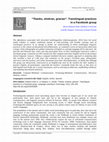
The affordances associated with networked multilingualism (Androutsopoulos, 2015) have led social... more The affordances associated with networked multilingualism (Androutsopoulos, 2015) have led social media scholars to replace traditional notions of code-switching with broader concepts such as translingual practices. In an attempt to further our understanding of online multilingual linguistic practices in the context of educational telecollaboration, we examined a series of interactions taken from a larger online ethnography of a global community of English as a foreign language (EFL) educators. We describe and illustrate how, when, and why participants drew on their multilingual repertoires within a Facebook group, created by two EFL teachers for their students and where English served as the primary shared linguistic resource. Taking a computer-mediated discourse analytic approach to analyzing data that included a total of 1,206 posts and comments on the group's Facebook page, ethnographic interviews with the teachers, and online documents from their telecollaboration, we found that although this group was discursively constructed as an English-only zone by the teachers for their students to practice English, all participants—especially the teachers—eventually broke this rule, as they drew on both Spanish and Arabic for a variety of purposes, such as selecting an addressee, establishing solidarity, and modeling intercultural sensitivity.

A b S T R A C T In this article, the authors offer a comparative approach to the analysis of a po... more A b S T R A C T In this article, the authors offer a comparative approach to the analysis of a popular internet genre – user-generated restaurant reviews – sampled from two different websites (OpenRice and Yelp), which have emerged from two different geographic contexts (Hong Kong and the US). Their investigation reveals both similarities and differences of in terms of review format, content discussed and the use of several semiotic resources, such as the posting of photographs, the use of emoticons and emoji, and the expressive use of orthography and punctuation. The authors demonstrate that, while many of the formal properties of the genre are quite similar, some variations in review content may reflect underlying cultural differences. Furthermore, they show not only how the website's architecture can either constrain or encourage the use (or non-use) of particular semiotic resources, but also suggest that other variables (i.e. orthographic systems, review community norms) may interact with medium factors. k e y W O R D S multimodality • online reviews • restaurant reviews • user-generated content • website interface
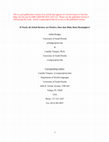
Peer-to-peer business models rely on interpersonal communication for their success. In this artic... more Peer-to-peer business models rely on interpersonal communication for their success. In this article, we focus on Airbnb – an exemplar of the so-called ‘sharing economy’ – and more specifically, on Airbnb’s reciprocal reviewing system, which enables both hosts and guests to review one another. Our study takes a computer-assisted, qualitative approach to explore linguistic patterns of evaluation in Airbnb reviews. Our findings indicate that Airbnb reviews tend to comprise a very restricted set of linguistic resources, establishing the site’s norm of highly positive commentary, which in turn makes Airbnb reviews, on the surface, appear to be quite similar to one another. However, a micro-analytic comparison of positive reviews reveals that less-than-positive experiences are sometimes communicated using more nuanced, subtle cues. This study contributes to existing literature on electronic word of mouth (eWOM) in the tourism industry by highlighting how evaluation is communicated, while simultaneously responding to hospitality scholars’ calls for analyses which extend beyond the star ratings and also take into account consumers’ constructions of experience in the review texts themselves.
Vásquez, C. (2016). Intertextuality and authorized transgression in parodies of online consumer ... more Vásquez, C. (2016). Intertextuality and authorized transgression in parodies of online consumer reviews. Language@Internet, 13, article 6.
Language Teaching Research, 2009
Journal of Sociolinguistics, 2008
Comparative Education Review, 2010
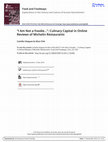
This article adds to the growing literature on foodie discourse, by providing an analysis of amat... more This article adds to the growing literature on foodie discourse, by providing an analysis of amateur reviews of one-star Michelin restaurants sampled from two different websites, OpenRice and Yelp, which reflect two different geocultural contexts: Hong Kong and New York City. We demonstrate that online restaurant reviews provide a means through which individuals can display their culinary capital-to an audience who is likely to share similar interests-as they establish their expertise on matters such as authenticity, taste, quality, and the perceived value of their dining experiences. Furthermore, we explore how issues of social class and access to economic capital are implicated in user-generated reviews of this category of restaurants. By asserting their right to participate in a larger conversation about Michelin standards, online reviewers place themselves on equal footing with culinary elites and professional food reviewers. Consequently, we argue that new media genres such as online reviews challenge well-established hierarchies in food culture, yet at the same time, they also reproduce some existing forms of culinary capital.
Discourse & Communication, 2007
R EFER ENC ES Bauman, R. and Briggs, C. (2000) 'Language Philosophy as Language Ideology: Jo... more R EFER ENC ES Bauman, R. and Briggs, C. (2000) 'Language Philosophy as Language Ideology: John Locke and Johann Gottfried Herder', in PV Kroskrity (ed.) Regimes of Language. Ideologies, Polities, and Identities, pp. 139204. Santa Fe, NM: School of ...
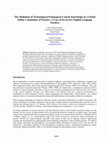
SITE 2013 Conference Proceeding, 2013
Situated in communities of practice (CoP) and technological pedagogical content knowledge (TPACK)... more Situated in communities of practice (CoP) and technological pedagogical content knowledge (TPACK) frameworks, this multiple case study explores the mediation of TPACK in a globally-distributed online community of practice of English language teachers, called Webheads in Action (WiA). Derived from a larger online ethnography conducted with this community, the study uses field notes from online participant observation, interviews, and archived email data to describe the characteristics of this community's activities and culture, as well as two selected members' lived experiences in their involvement with this community as it pertains to pedagogically-sound technology integration. Through content and inductive analysis, we demonstrate ways of and argue for the potential of developing an understanding of meaningful technology integration through participation in an online community of practice, which provides a mediational space for in-service English language teachers.

Journal article, May 2013
Netnography is an approach to studying online communities and cultures to arrive at an ethnograph... more Netnography is an approach to studying online communities and cultures to arrive at an ethnographic understanding. Drawing on our own experiences and methodological choices in a netnography of a multi-site online community of practice of English language teachers, known as Webheads in Action, this article illustrates how ethnographic fieldwork practices change when carried out with communities that exist primarily online. Focusing on illustrative examples from our 10-month netnographic fieldwork data, we argue that concepts of ‘the field, participant observation, interviews, and researcher survival skills’ are experienced in fundamentally different ways in netnography as opposed to in-person ethnography, which calls for reconceptualisation of fieldwork practices in online communities because of the dynamics of online environments and the use of web-based technologies.
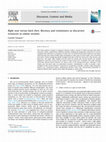
This study explores variation in temporal reference within a dataset of 1000 user-generated onlin... more This study explores variation in temporal reference within a dataset of 1000 user-generated online consumer reviews, sampled from 5 different websites. Analyzing the proportion of references to recency compared with references to remoteness in these texts, an overall trend toward remoteness was found, which diverges from earlier findings about temporality in other types of social media, such as Facebook and Twitter. Further considering specific examples from three of the five review sites (Yelp, Amazon, and Epicurious), this paper offers insights into how both the remote past and the present are variably deployed as discursive resources by the authors of these online texts. In addition, the study's findings reveal that whereas lexical resources are used to refer to the present/recent past, references to the remote past rely much more on grammatical resources. Consequently, in order to provide a more complete account of time reference, I argue that it is important to consider a broader range of linguistic features (e.g., grammatical aspect, prepositional phrases) rather than concentrating exclusively on temporal adverbs when making claims about temporality in social media.
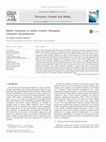
In this study we investigate the generic structure of hotel responses to customer complaints post... more In this study we investigate the generic structure of hotel responses to customer complaints posted on popular travel website, TripAdvisor. Extending the genre analytic notion of rhetorical moves ( 48 and 50) to this computer-mediated text type, we analyzed 80 hotel replies that were posted in response to online consumer complaints. Our analysis of the responses of 4- and 5-star hotels located in 4 popular urban tourist destinations in China indicates that ten move types are commonly found in this genre, with eight of these appearing in the majority of reviews. These results suggest that online responses from businesses replying to user-generated reviews tend to be highly formulaic and conventionalized, with thanking and apologizing among the most common moves identified. However, we also found considerable variation with respect to how specific hotels were about addressing the problem(s) discussed in the original customer complaint, as well as the extent to which hotel management indicated having taken actions to correct those problems. Finally, our study found that in this set of responses, hotel personnel tended to emphasize a corporate (rather than personal) identity when constructing responses to complaints. The study׳s findings provide insights into some of the ways in which businesses are managing consumer dissatisfaction online.
Keywords
Online complaints; TripAdvisor hotel reviews; Electronic word of mouth; Reputation management; Business CMC; Move analysis
Drawing on recent work on digital narratives of personal experience in online genres such as emai... more Drawing on recent work on digital narratives of personal experience in online genres such as email, social networking sites, and blogs, the present study explores narrative features in 100 online consumer reviews of hotels. Focusing on negative reviews, or "Rants, " from popular consumer travel platform, TripAdvisor, the article examines both canonical and genre-specific structural features of narratives, as well as some of the discursive resources used by online narrators to engage their audiences, and to draw them into their stories. Specifically, the study explores the use of story prefaces and related forms of second person address, represented speech and mental states, and deictic shifts, and suggests that narrative features such as these are useful in attracting the attention of an audience amidst a vast universe of online information.











Uploads
Papers by Camilla Vasquez
Keywords
Online complaints; TripAdvisor hotel reviews; Electronic word of mouth; Reputation management; Business CMC; Move analysis
Keywords
Online complaints; TripAdvisor hotel reviews; Electronic word of mouth; Reputation management; Business CMC; Move analysis